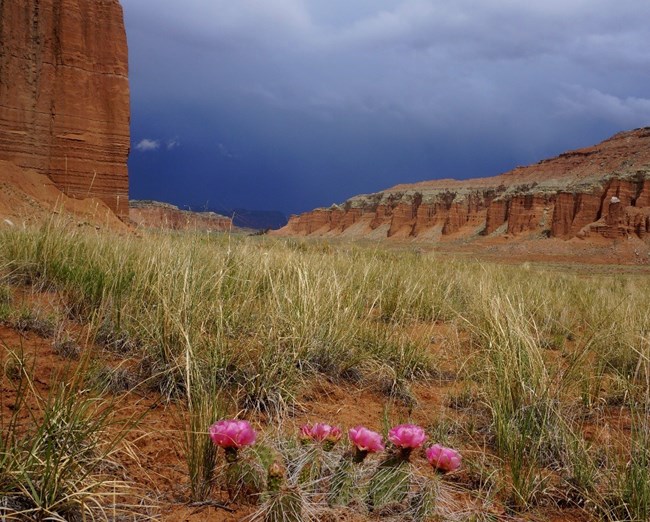Last updated: April 12, 2021
Article
Traits, Tradeoffs, and Pivot Points: How Climate, Plant, and Soil Properties Affect Vegetation Growth on the Northern Colorado Plateau

As the northern Colorado Plateau heads into a hotter, drier future, there will be ecological winners and losers. Figuring out how different vegetation communities will fare is tricky. A recent study aimed to identify which vegetation communities might come out ahead, which might lag behind, and what might make the difference.
Like cars with different body types and horsepower, plant species have different adaptations and growth rates. For example, a sports car can out-perform a pickup on the highway, but a pickup truck can out-perform a sports car on a bumpy dirt road. Both travel easily on the highway, but each has traits best-suited to different environments, and those traits come with tradeoffs. Similarly, all plants do better when conditions are good for growth, but fast-growing species (“responders”) tend to crowd out slower-growing competitors. When growth conditions are poor, drought-resistant species (“resisters”) do better, while responders may perish. Over time, these adaptations to local climate sort plant species into vegetation communities able to persist under prevailing conditions.
But what if those prevailing conditions change? As gardeners and farmers know, certain traits make certain species well-suited to their environments. Scientists from the Northern Colorado Plateau Network (NCPN) and U.S. Geological Survey used satellite imagery to broaden the view, analyzing how entire communities of native plants performed under varying conditions over time. They used data for wet and dry periods at 520 sites in seven national parks over a 15-year period.

The study revealed that traits and tradeoffs also occur at the landscape scale. Vegetation communities in wetter regions, such as pinyon-juniper and sagebrush steppe, proved more responsive to moisture, but more susceptible to drought. Communities in drier regions, such as blackbrush and desert grasslands, were more resistant to drought but less able to grow quickly under favorable conditions.
To help park managers know which communities might be most drought-resistant, the study’s authors identified “pivot points” for each community. The pivot point is the amount of water where vegetation production teeters between below and above average condition. The authors also determined growth rates for different plant communities in droughty (bumpy) or moist (smooth) years. Combined, this information suggests how different vegetation communities may fare in a warmer, drier climate.

Graphic by climateanalyzer.org
Here’s an example of how climate data can be used to estimate vegetation condition. In September 2018, Capitol Reef National Park was experiencing its worst drought since 2000. In the figure at right, the horizontal orange line is the drought-stress pivot point for the Hartnet area. The red line is the 2018 water deficit (an estimate of drought stress). When the red line rises above the orange line, then vegetation production is likely to be below average, favoring communities with greater resistance.
However, the September figures showed an “extremely bumpy dirt road” kind of year, in which all communities in this area were likely suffering. If the road plants are on is bad enough or long enough, it will become impassable, even for drought-adapted species that could otherwise coast through a less-severe dry spell. Ultimately, the plant community may change to a new group of species from drier environments—including weeds, which often arrive first.
Having a look “under the hood” revealed that soil properties can help “turbocharge” a location, making it more productive. In dry, sandy areas, a little clay helps hold water. In moister, clayey areas, a little sand helps water infiltrate to deeper depths where it can be stored for later use. These properties give a boost to some vegetation types in dry years.
In the southwestern U.S., climate, soil properties and site characteristics interact to affect water balance and vegetation growth. Now that scientists have untangled some of these interactions, managers have new insight to current conditions and what the future may hold—and can start planning for it. Anticipating how vegetation may change with climate is akin to knowing the road ahead, and figuring out which vehicle will be right for the conditions.
To learn more, see D. P. Thoma, S. M. Munson, and D. L. Witwicki, Landscape pivot points and responses to water balance in national parks of the southwest US. Journal of Applied Ecology, July 2018.
Print this brief
Tags
- arches national park
- black canyon of the gunnison national park
- canyonlands national park
- capitol reef national park
- curecanti national recreation area
- dinosaur national monument
- zion national park
- capitol reef national park
- ncpn
- northern colorado plateau network
- northern colorado plateau
- monitoring
- vegetation and soils
- climate
- adaptation
- zion national park
- arches national park
- canyonlands national park
- black canyon of the gunnison national park
- curecanti national recreation area
- dinosaur national monument
- climate change effects
- climate change adaptation
- research
- climate change
- climate science
- waterbalancecc
